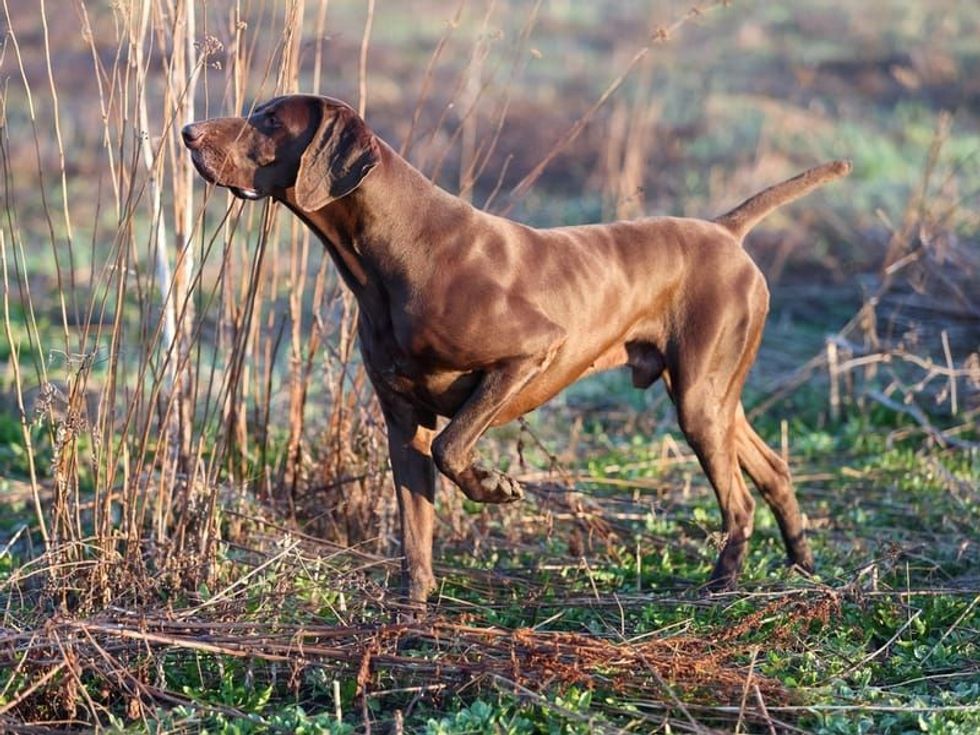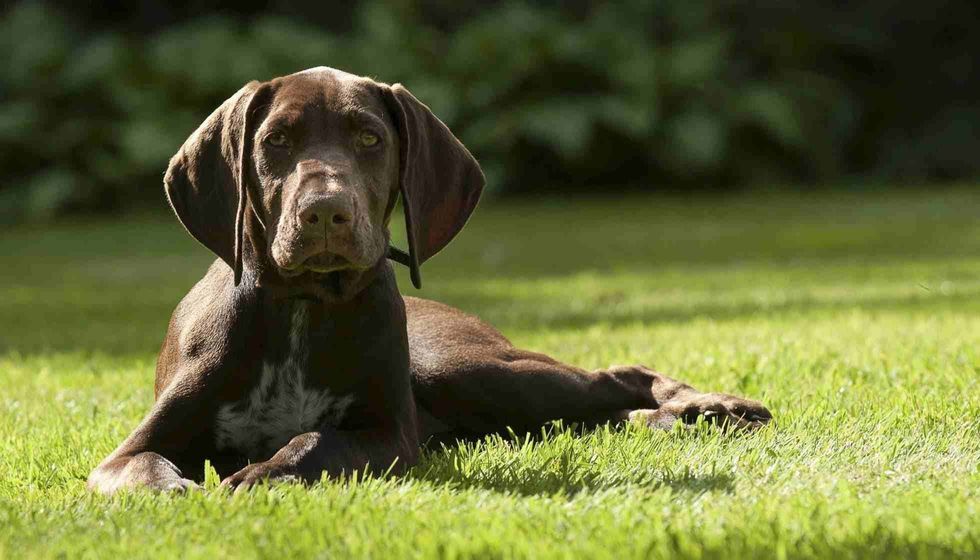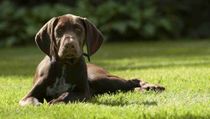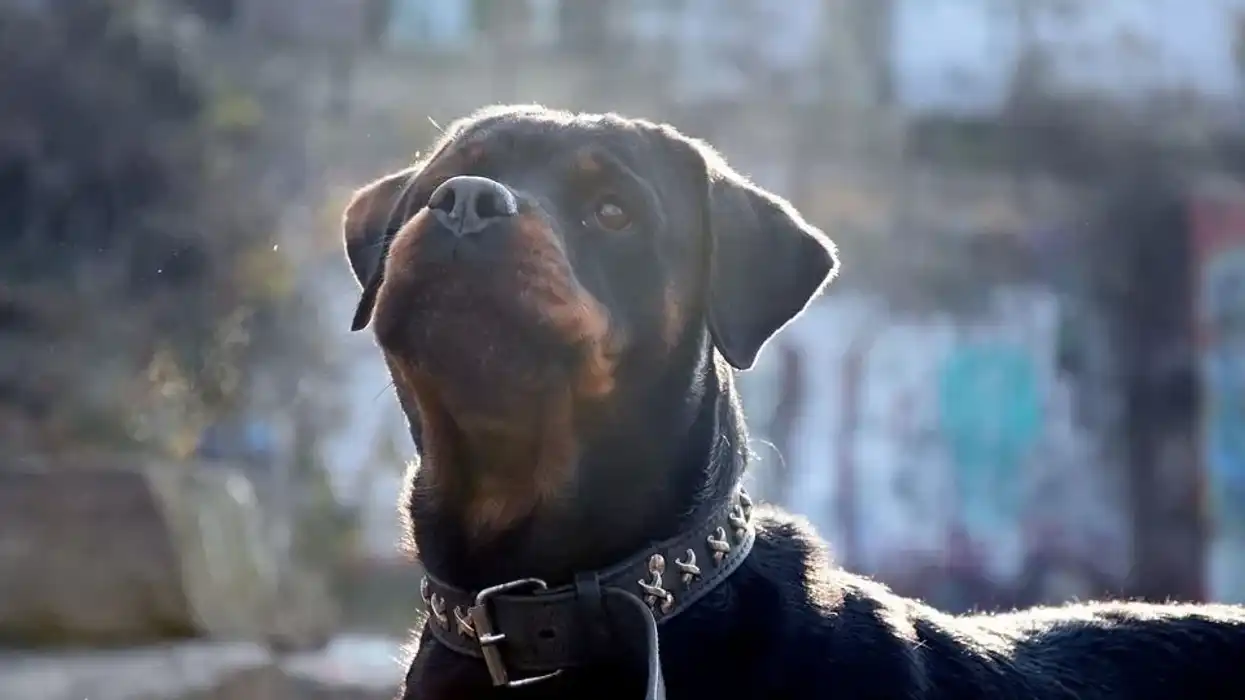Fun German Shorthaired Pointer Facts For Kids
The German shorthaired pointer (GSP) is a medium-sized gun dog breed that was developed in Germany. The breed carries mixed genes of German bird dogs, native German scent hounds, English pointers, and Spanish pointers.
The mixed breeding made the German shorthaired pointers an all-purpose dog breed that is pointers and retrievers. The versatile GSP is a sporting dog breed that can hunt and retrieve for games on land, and water.
They have a short, easy-care coat that requires less grooming, but these dogs are big shedders. German Shorthaired Pointer colors are mostly silver, or silver and white. This agile, gun dog breed requires plenty of exercise.
These dogs make affectionate pets and like to cuddle but have low tolerance towards other animals. Along with exercise requirements, these high-energy dogs also need attention, company, and care to lead a healthy life. The German shorthaired pointer is a member of the AKC sporting group of dogs.
For more relatable content, check out these Welsh terrier facts and Dogo Argentino facts!
German Shorthaired Pointer Interesting Facts
What type of animal is a German Shorthaired Pointer?
German shorthaired pointers are versatile hunting dogs with extremely high energy levels.
What class of animal does a German Shorthaired Pointer belong to?
German shorthaired pointers, or GSPs, belong to the class Mammalia. This versatile, traditional German dog is a high-energy breed. The German shorthaired pointer temperament allows it to be an extremely loyal and affectionate family dog. GSPs are close relatives of the German wirehaired pointer dog breed.
How many German Shorthaired Pointers are there in the world?
It is difficult to say how many German shorthaired pointers are there in the world. This sporting group of German breed is quite popular in the United States.
According to the AKC, this dog was ranked ninth in the list of the most popular dogs in America in 2018. A GSP puppy is intelligent, and always eager to please its owner.
Where does a German Shorthaired Pointer live?
A German shorthaired pointer lives in a home with its owner and its human family. The GSPs love water and have webbed feet that help them retrieve game from the water. These hunting dogs were specially bred for pointing, chasing, and retrieving injured or dead birds and wild animals.
They mostly helped their masters in hunting quails, pheasants, raccoons, rabbits, and bigger animals like deer. The German shorthaired pointer hunting dog is an all-rounder, in the past, they were mostly companions of hunters and lived in country homes but now they are found in all kinds of homes.
What is a German Shorthaired Pointer's habitat?
GSPs can adjust in apartments but that’s not recommended for these pointing and hunting dogs. They love to run, chase, and dig, which can only happen in homes with a yard. A large yard with high fencing is ideal for GSPs. If they don’t get enough exercise, GSPs may land up with different health conditions.
These dogs following their high prey drive and hunting instincts may wander in the wild following scents. GSPs can tolerate warmer weather better than extremely cold weather. They make good family dogs for outdoorsy families who like to run, hike, bike, and do outdoor activities with their pets.
Because of their intelligence and curious nature, GSP puppies are safer to be left in their crates when unsurprised. A German shorthaired pointer puppy may get into mischief or may escape at the first chance it gets.
Who do German Shorthaired Pointers live with?
GSPs are lone workers and do not hunt in groups. They usually go hunting with their masters alone and not in packs. They live inside homes with their owners.
Due to their hunting-dog heritage, these pointing dogs do not do well with small animals like cats, rabbits, and other small pets. These dogs may see them as prey and be aggressive. German shorthaired pointers work well with their masters but are independent thinkers.
German shorthaired pointers make good guard dogs too. They will bark and alert their master if they see strangers, intruders, or trespassers within their boundary. However, these dogs do not indulge in unnecessary aggression. That makes them well-mannered alarm dogs.
How long does a German Shorthaired Pointer live?
The average life span of a German shorthaired pointer is 12-14 years.
How do they reproduce?
There are generally eight to twelve puppies born to a female German Shorthaired Pointer in a litter. However, more than twelve is also not rare. The GSP dog’s litter is considered to be larger than other dog breeds of their size. Usually, GSP female dogs have a smooth birthing experience if not the dog is too old.
The female dog may rest while birthing and whelp a pair of puppies at a time. In the wild or in farms where the dogs may not be kept indoors, female German shorthaired pointers dig dens to give birth to puppies. In homes, the mother dog should be given a cozy bed and some privacy.
What is their conservation status?
The conservation status of German shorthaired pointers is of the Least Concern.
German Shorthaired Pointer Fun Facts
What do German Shorthaired Pointers look like?

When the German Shorthaired Pointer puppies are born, most of their coat is white with silver patches. As they grow, the coat fills up with different shades of brown.
The coat is sometimes black and white and there are also some tricolored GSPs but they are not accepted by the AKC standards. German Shorthaired Pointer size can be considered to be medium to large. They have a well-muscled body with a toned athlete built and a striking outline.
The head and the muzzle are both squarish. This breed has long, high-set, droopy velvety ears. The eyes are set back in their skull.
The dogs have their tails docked high. In dog sports and competitions, a GSP is penalized if the tail curves up or down when it is running.
The ticking on the dog’s coat becomes visible in puppies when they are around five weeks old. Most of the dogs of this breed continue to get a darker shade of coat with age. The short coat makes it an easy-grooming dog breed.
The upper coat is backed by a dense undercoat protected by firm ‘guard hair’. Their coat keeps them warm and is water-resistant. As hunting dogs, these physiological features help them in their job on land and in water which they are adept in and mostly love.
How cute are they?
German shorthaired pointers are adorable dogs. Despite being hunting dogs, they are not aggressive and have a sweet temperament. These highly energetic dogs are cute and playful.
They need the attention of their owners and may be destructive if ignored or left alone. German Shorthaired Pointer rescue dogs often face difficulty in getting new homes. But, they make excellent, loyal, friendly, family dogs.
How do they communicate?
Most pointer breeds do not tend to bark too much and the same goes for the GSP. When well-exercised and trained properly, these dogs are not loud at all. They develop a barking habit if they are bored, unattended, or want to alert the owner of some danger or a stranger.
High-energy dogs need at least an hour of vigorous exercise every day. A simple walk in the park is not enough for a GSP puppy.
They also exhibit bodily signs when scared, nervous, excited, or feeling aggressive. The owner requires to understand what the dog is feeling. That’s what a good bond between a dog and its owner is all about!
How big is a German Shorthaired Pointer?
Compared to a Chihuahua, which is about 8 in (20.3 cm) tall, a GSP is more than three times taller with a height of 25 in (63.5 cm).
How fast can a German Shorthaired Pointer run?
A healthy, adult German Shorthaired Pointer can run at the speed of 35-45 mph (56.3-72.4 kph).
How much does a German Shorthaired Pointer weigh?
The weight of male GSPs is in the range of 55.1-70.6 lb (25–32 kg). The weight of females is 44.1-59.5 lb (20-27 kg).
What are the male and female names of the species?
A male GSP is called a dog and a female is called a bitch.
What would you call a baby German Shorthaired Pointer?
A baby GSP is called a puppy.
What do they eat?
A German shorthaired pointer’s diet should include fresh and high-quality ingredients. To maintain its muscular body and high energy lifestyle, the dog needs food like chicken, fish, turkey, eggs, and other high-protein foods.
Some rice and sweet potato can be given as a source of carbohydrates. This breed has a sensitive digestive system. Peas, onion, garlic, and potatoes should be avoided.
German shorthaired pointers love to please their owners and admire rewards for good behavior. Raw or steamed carrots, green beans, plain bread, some cheese, coconut, honey, maybe good treats to offer while training.
They may also be given high-quality commercial food or healthy homemade dog food. Balanced nutrition is required for a good and healthy life for these gun dogs.
Are they slobbery?
No! German shorthaired pointers are not slobbery at all. They often drool when eating or drinking, but other than that, they do not slobber at all.
Would they make a good pet?
GSPs make excellent family dogs, but they need serious exercise every day for at least an hour. These playful and intelligent dogs do well with access to a fairly large-sized yard.
They are good in obedience training and that makes them skilled in dog sports too. Although this is a healthy breed they may face some health conditions like bloating, hip dysplasia, cancer, Von Willebrand's disease, etc.
German Shorthaired Pointer price may range from $600-$1,000 depending on the lineage. Some German Shorthaired Pointer breeders also sell good pedigree dogs for $1,300-$5,500.
German Shorthaired Pointer shedding is seasonal but moderately high. Rooming needs are low and their coat is easy to maintain.
Did you know...
In America, the GSP was introduced in the Wisconsin and Minnesota areas.
The GSP breed was first entered into the AKC Stud Book in 1930. The AKC recognized the GSP as a breed officially in 1936.
The German shorthaired pointer lab mix-breeds are called ‘Pointerdors.’
Guarding resources or food aggression is a common aggressive behavior in German shorthaired pointers. This should be checked at the puppy stage to avoid serious problems later.
How to train a German Shorthaired Pointer?
Training GSPs is moderately easy. They are obedient, intelligent, and eager to please, and are responsive in training sessions. They are quick and eager learners and do not need many resources for training. These pooches carefully listen to instructions during the training sessions.
Consistent effort, reward-based training helps. These dogs should be trained and socialized from a young age. These dogs do well in many AKC dog sports with agility, obedience, and field events like flyball, rally, dock diving, etc.
What breeds make up a German Shorthaired Pointer?
The existence of pointers can be traced back to the sixteenth or seventeenth century. Some dog breeds were created as hunting resources or to point to birds. The main task of these dogs was to alert their owner about the direction of a game bird for convenient hunting.
The German Shorthaired Pointer breeders created this breed in the nineteenth century for the same purpose by breeding German bird dogs with Spanish Pointers. The exact lineage of these dogs is hard to trace.
They are thought to be a blend of at least four canine varieties - German bird dogs, native German scent hounds, English Pointers, and Spanish Pointers.
Here at Kidadl, we have carefully created lots of interesting family-friendly animal facts for everyone to discover! Learn more about some other mammals from our dorkie facts and chug dog facts pages.
You can even occupy yourself at home by coloring in one of our German Wirehaired Pointer coloring pages.
We Want Your Photos!
More for You
See All
Bachelor of Arts specializing in Linguistics

Martha MartinsBachelor of Arts specializing in Linguistics
Martha is a full-time creative writer, content strategist, and aspiring screenwriter who communicates complex thoughts and ideas effectively. She has completed her Bachelor's in Linguistics from Nasarawa State University. As an enthusiast of public relations and communication, Martha is well-prepared to substantially impact your organization as your next content writer and strategist. Her dedication to her craft and commitment to delivering high-quality work enables her to create compelling content that resonates with audiences.
Disclaimer
1) Kidadl is independent and to make our service free to you the reader we are supported by advertising. We hope you love our recommendations for products and services! What we suggest is selected independently by the Kidadl team. If you purchase using the Buy Now button we may earn a small commission. This does not influence our choices. Prices are correct and items are available at the time the article was published but we cannot guarantee that on the time of reading. Please note that Kidadl is a participant in the Amazon Services LLC Associates Program, an affiliate advertising program designed to provide a means for sites to earn advertising fees by advertising and linking to Amazon. We also link to other websites, but are not responsible for their content.
2) At Kidadl, we strive to recommend the very best activities and events. We will always aim to give you accurate information at the date of publication - however, information does change, so it’s important you do your own research, double-check and make the decision that is right for your family. We recognise that not all activities and ideas are appropriate for all children and families or in all circumstances. Our recommended activities are based on age but these are a guide. We recommend that these ideas are used as inspiration, that ideas are undertaken with appropriate adult supervision, and that each adult uses their own discretion and knowledge of their children to consider the safety and suitability. Kidadl cannot accept liability for the execution of these ideas, and parental supervision is advised at all times, as safety is paramount. Anyone using the information provided by Kidadl does so at their own risk and we can not accept liability if things go wrong.
3) Because we are an educational resource, we have quotes and facts about a range of historical and modern figures. We do not endorse the actions of or rhetoric of all the people included in these collections, but we think they are important for growing minds to learn about under the guidance of parents or guardians.







